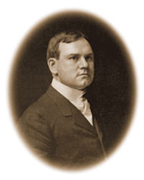William R. WareWilliam R. Ware was born on May 27, 1832 in Cambridge, Massachusetts into a well-known Unitarian family, the son of Henry Ware, Jr. and Mary Lovell (Pickard) Ware. Ware is not as well known for his achievements as an architect, though he and Van Brunt designed and erected a number of noteworthy buildings, especially in the Boston and Cambridge areas. Ware is best known as an educator and as the founder of the schools of architecture at the Massachusetts Institute of Technology (MIT) and Columbia University. In addition to his role as an educator, he contributed to the establishment of the high standards of competition maintained by the American Institute of Architects (AIA), and wrote many significant papers and textbooks in the field. It was during the 1901 Pennsylvania Capitol design competition that the Capitol Building Commission sought Professor Ware as its consulting architect. When the competition ended on November 20, 1901 it was Ware's responsibility to review all of the submissions. In all, the Commission had received nine entries that were numbered so that Ware could review them without knowing the names of the submitters. Ware went before the Commission on December 28 to discuss his conclusions. He stated that he had commented on each plan by number. He did not, however, rank any of the plans, but selected four that he thought were superior, three that were lesser, and two that should not even be considered because they were distinctly poorer than the rest. He stated that the Commission would be justified in selecting any of the first four designs, and reiterated that his evaluations had been made without knowing any of the names of the architects. There was a period of general reviewing by the Commission, and then the members proceeded to debate the four that Ware had suggested — narrowing the field to numbers four and one. The Commission asked Ware if they would be justified in selecting either entry, and he replied in the affirmative, if the authors were of known reputation. Finally, the Commission was ready to vote on the plans, but they asked Ware one last question as to whether they should cancel the competition altogether and begin anew. Ware stated that he thought this would be counterproductive, wasteful of time and money, and most likely would not provide entries any better than the ones already in hand. Following this assertion, the Commission voted. After an informal vote they chose entry number one, which when uncovered read, "J. M. Huston, Philadelphia." In addition to Huston, the names of the six known entrants were: William C. Hays, Addison Hutton, Herman Miller, Fred J. Osterling, Trimble and Stevens, and James H. Warner. Joseph Miller Huston, the selected architect, was a thirty-five-year-old resident of Germantown, Pennsylvania. He had grand ideas, but little experience within the field, and certainly he had never attempted anything as large as the scale of his plans for the Capitol. Professor Ware, as consultant to the Commission, did issue a caveat regarding Huston's selection, primarily based on his youth and inexperience as an architect undertaking a project as large as the Capitol. Ware stated:
The Commission only followed Ware's advice loosely. Though they never officially asked Huston to choose a consulting architect, the Commission hired Bernard R. Green, the former superintendent at the Library of Congress, to serve as clerk-of-the-works for the Capitol. Joseph Huston received a congratulatory letter from William Ware on December 30, 1901, informing him of his selection. From early January until mid-July 1902, Governor Stone, William Ware, Bernard Green, and Huston debated over changes and modifications that each wanted in the building, with Huston maintaining adherence to his original plans in most cases. |
WILLIAM R. WARE COMPETITIVE DRAWING JOSEPH M. HUSTON, |


